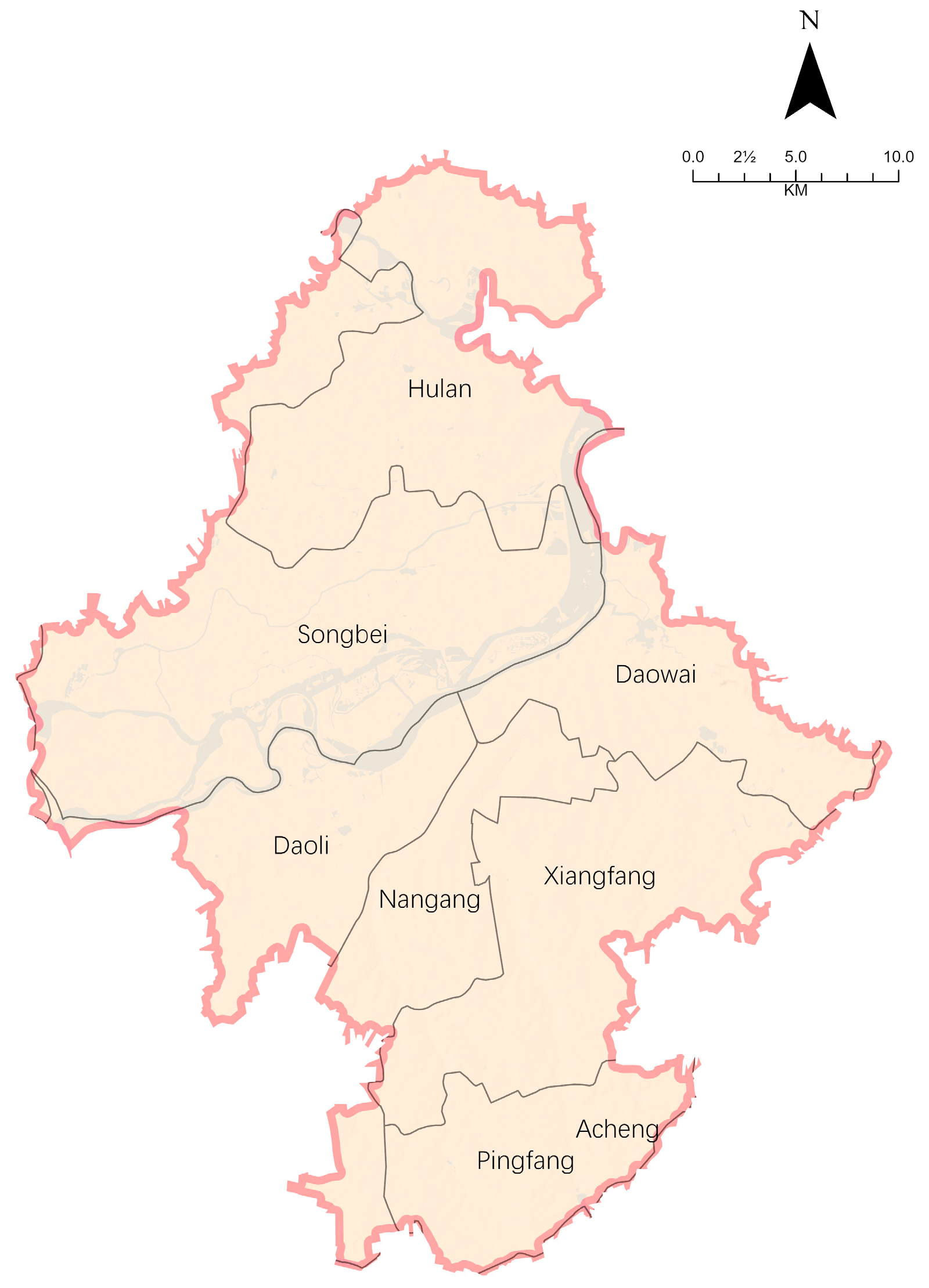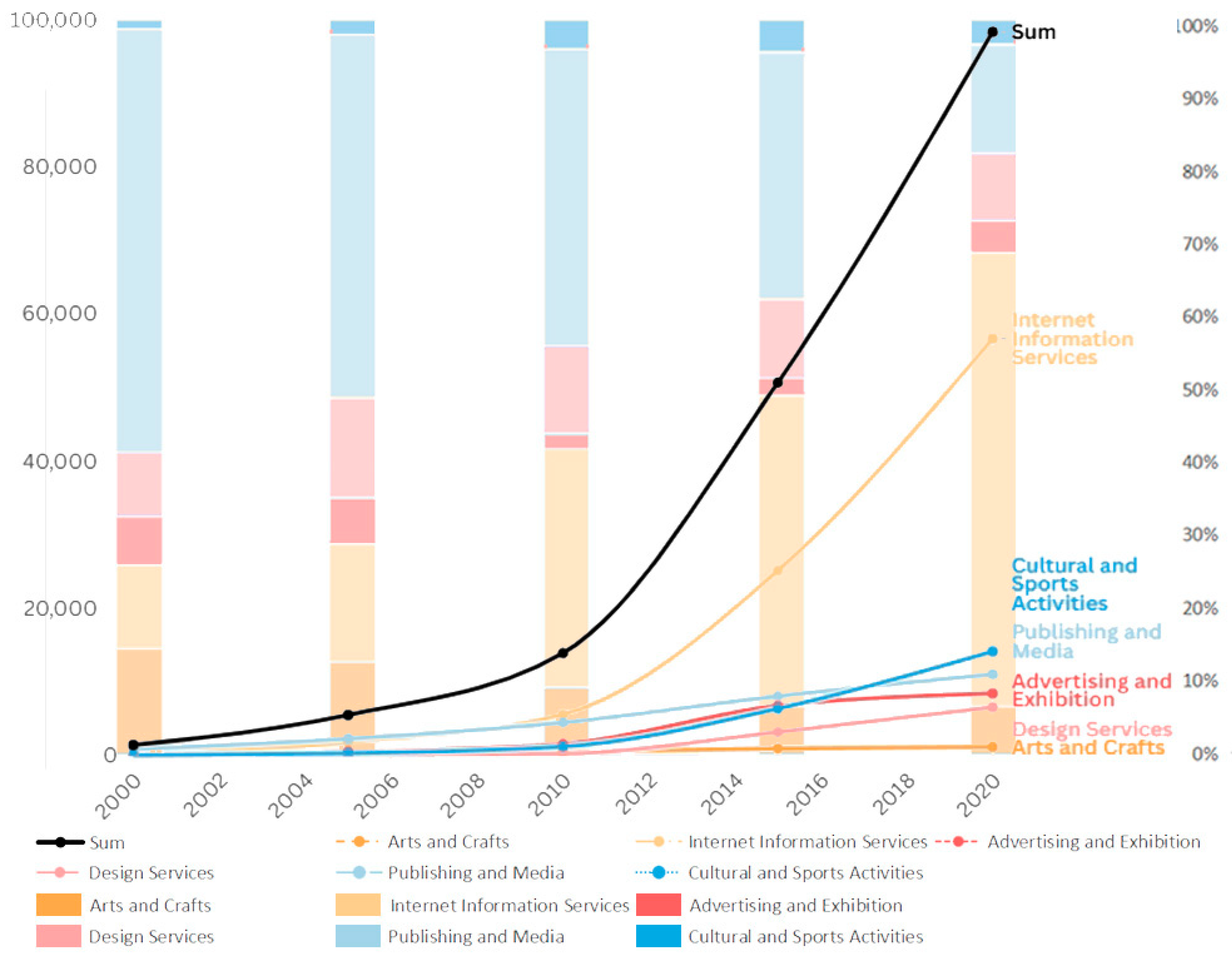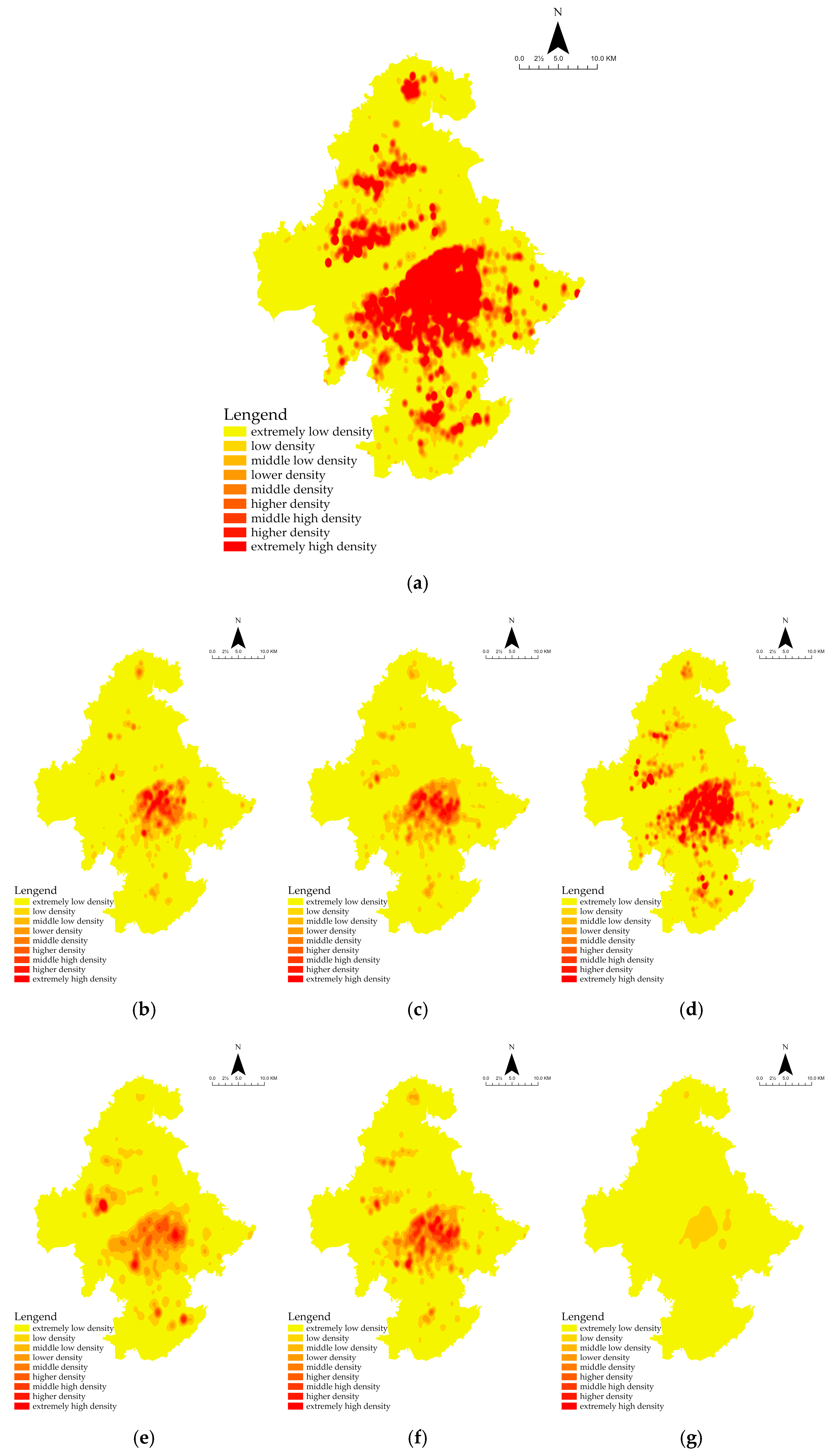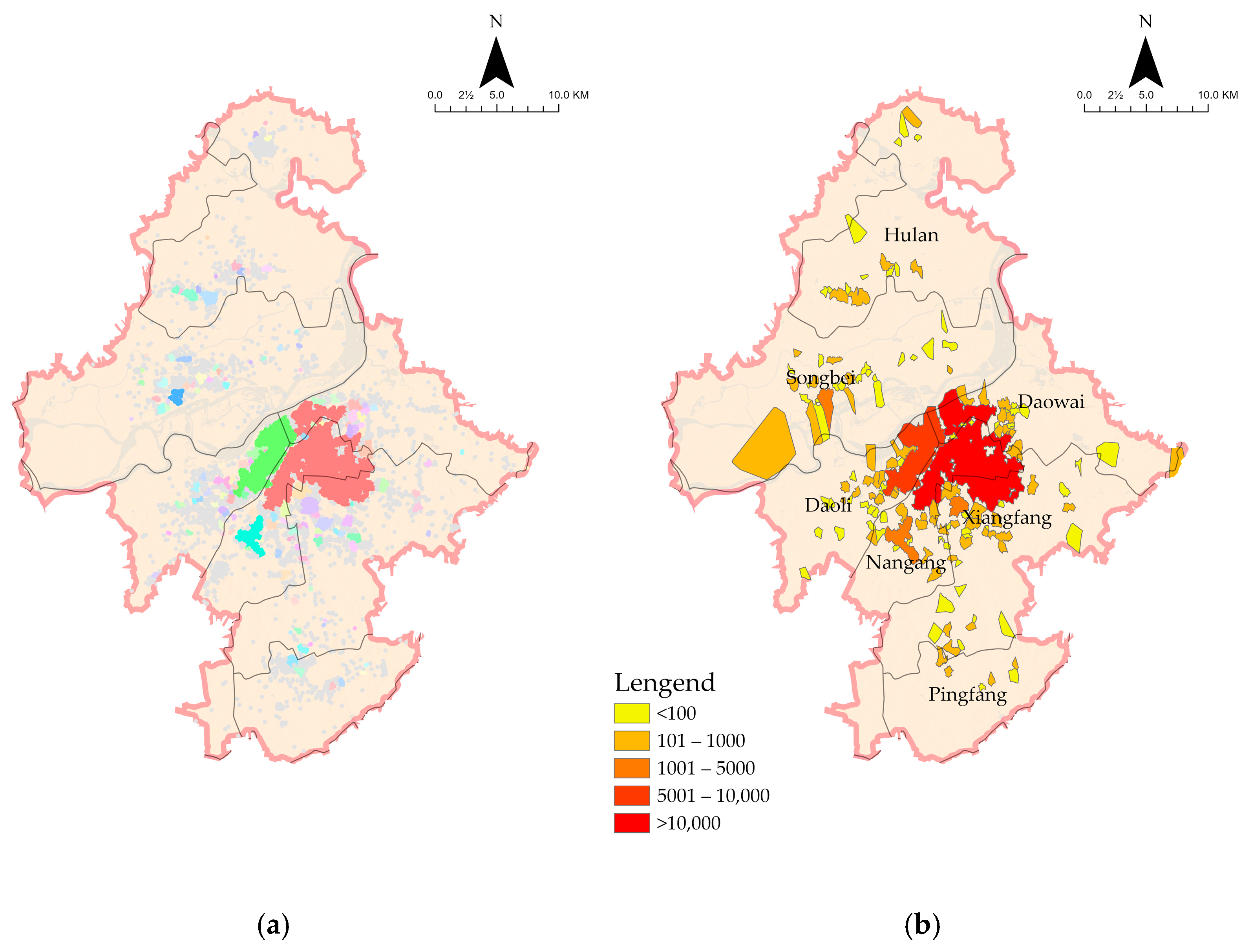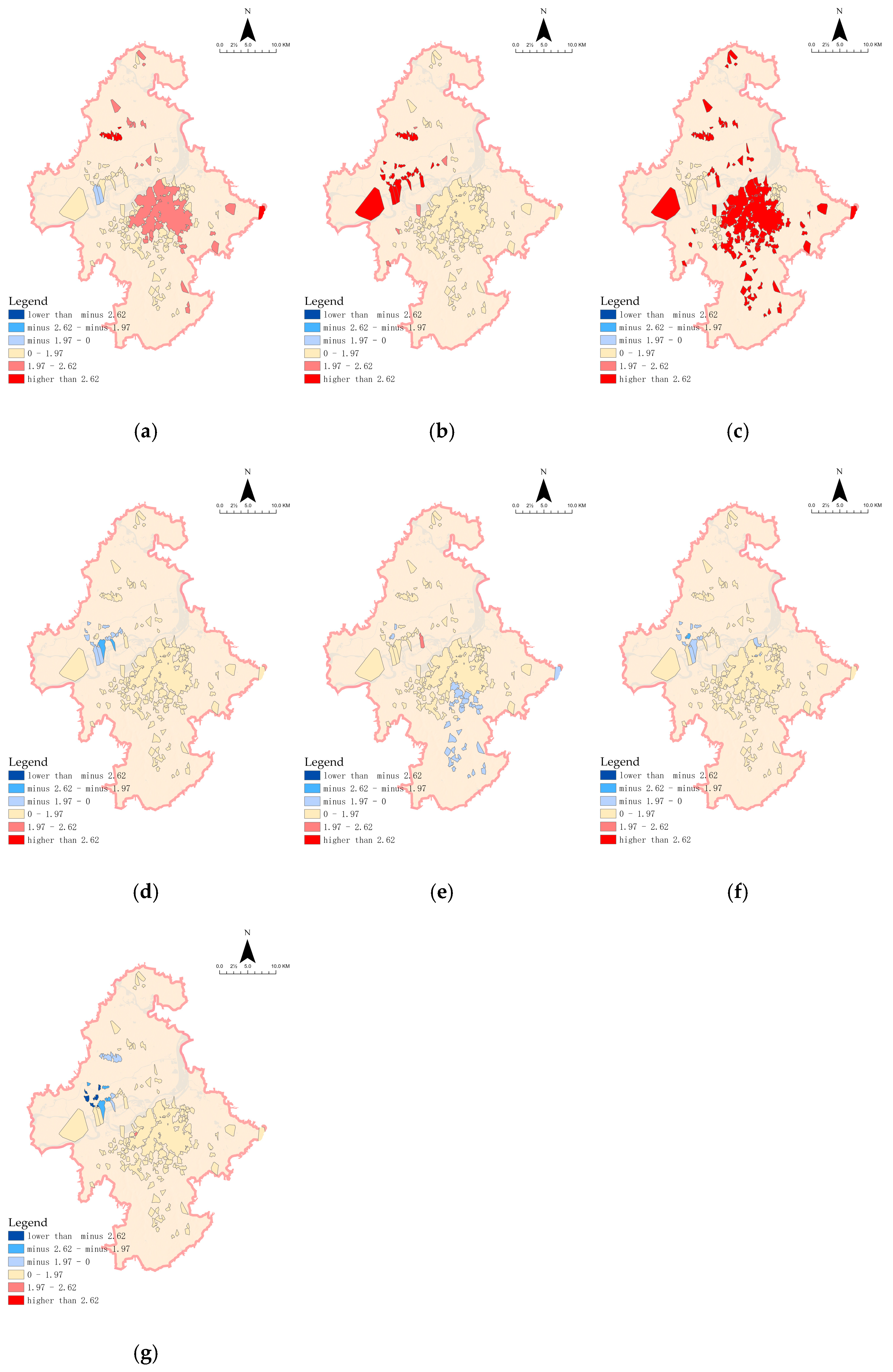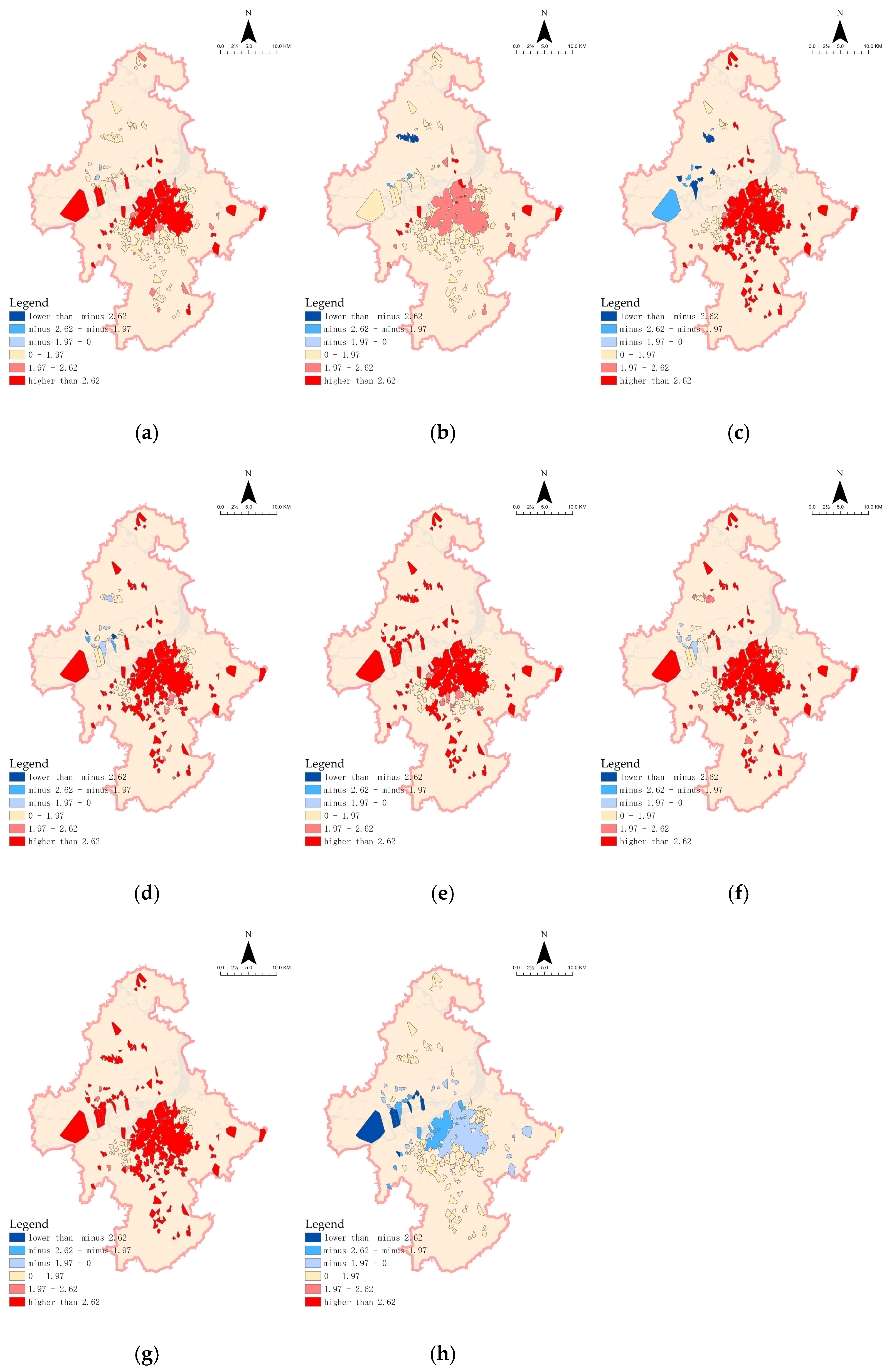3.3.1. OLS Analysis
We constructed an OLS model in GWR 4.0 software, yielding the analysis results (
Table 6).
Among the social impact factors, both public transportation convenience and new energy transportation infrastructure show a significant positive impact, demonstrating that accessibility plays a supportive role in the agglomeration of the cultural and creative industries. The density of public libraries exhibits a significant negative impact, which is possibly because its service radius covers the entire city, which weakens the proximity effect.
The overall impact of cultural impact factors is significant, with cultural and sports facilities and public art education facilities having relatively high regression coefficients, indicating that these physical cultural facilities can promote the formation of cultural creative clusters. Public information kiosks show a significant positive impact, proving that in the information age, the methods of public information dissemination still play an irreplaceable role in the agglomeration of the cultural and creative industries.
Economic impact factors exhibit the strongest explanatory power, with business office buildings having an exceptionally high regression coefficient, demonstrating the agglomeration effect of the business ecosystem in the CBD area on the cultural and creative industries. Night economic facilities show a significant negative impact, contrasting with findings from studies in southern cities, which is potentially due to the low-temperature environment leading to this difference. The positive impact of financial service facilities and dining service facilities indicates that the maturity of commercial supporting facilities plays a crucial role in the site selection of cultural and creative enterprises.
The regression results initially reveal the influence of the impact factors on the agglomeration of the cultural and creative industries. However, the traditional OLS model fails to account for the spatial heterogeneity of each factor, making it difficult to analyze the extent of the influence of each factor on the agglomeration of the cultural and creative industries. Therefore, a GWR approach is needed for a more detailed assessment.
3.3.2. Triple Impact Factor Comprehensive Analysis
We employ the GWR model to conduct local parameter estimation of the influencing factors of 20 indicators, revealing the spatial heterogeneity impact mechanisms of various factors on the agglomeration of the cultural and creative industries. The following sections systematically analyze the regression results from three dimensions, social, cultural, and economic, while also validating the rationality of the conclusions in conjunction with the characteristics of Harbin City and relevant domestic and international publications. We conducted a two-tailed t-distribution test. At a confidence level of α = 0.05, the degrees of freedom (df = 136) are calculated based on the sample size (n = 157) and the number of independent variables (k = 20), corresponding to a theoretical critical value of t ≈ 1.97. At a confidence level of α = 0.01, the corresponding theoretical critical value is t ≈ 2.62.
When the regression coefficient is greater than 1.97 or less than minus 1.97, it can be considered that there is a 95% probability of determining that the influence factor has a positive (negative) correlation with the cultural and creative industries, and when the regression coefficient is greater than 2.62 or less than minus 2.62, it can be considered that there is a 99% probability of determining that the influence factor has a positive (negative) correlation with the cultural and creative industries [
41]. According to the size of the regression coefficient, we classify the size of the correlation between the influence factor and the cultural and creative industry agglomeration into six types as follows: absolute negative correlation (
p ≤ −2.62), obvious negative correlation (−2.62 <
p ≤ −1.97), probable negative correlation (−1.97 <
p ≤ 0), probable positive correlation (0 <
p ≤ 1.97), obvious positive correlation (1.97 ≤
p ≤ 2.62), and absolute positive correlation (2.62 ≤
p).
First, through performing GWR analysis on each indicator and calculating the arithmetic average of the regression coefficients for indicators within the same category, we obtain the correlation results between the three main dimensions of impact factors and the number of cultural and creative industries (
Table 7).
The influence range of the social category influence factor is relatively small, the average regression coefficient is 1.578, and the positive correlation is not obvious for clusters that are smaller in size and farther away from the old city center (
Figure 6a). The culture category has the widest influence with an average regression coefficient is 3.848. This indicates that the improvement of cultural facilities and information dissemination facilities is crucial for the clustering and development of cultural and creative industries (
Figure 6b). The correlation of the economic category is also wide with an average regression coefficient of 2.691. Like the social category, the positive correlation shown for clusters which have a smaller area and are farther away from the old urban area is not obvious (
Figure 6c). Overall, we find that the cultural and creative industries are affected by more impact factors, but there is spatial heterogeneity in the mechanism of various types of impact factors.
By observing the results of the analysis, we found that the percentage of correlation clusters of different classes of influence factors is different. The social, cultural and economic influence factor categories have a significant influence on 42.68%, 77.56%, and 63.06% of the clusters, respectively (
Table 8).
3.3.3. 20 Impact Factor Regression Analysis
In the GWR analysis of 20 impact factors, each indicator has a unique regression coefficient in each cluster to illustrate its correlation with the dependent variable in that area, resulting in a total of 3140 regression coefficients (
Table 9).
The results show significant differences in the impact of various indicators on the development of the cultural and creative industries in Harbin. Among these, the popularity of new energy transportation infrastructure, cultural and sports facilities, entertainment service facilities, financial service facilities, convenience stores, business office buildings, and dining service facilities have statistically significant correlations with over 66.88% of the clusters in the study area, indicating that these seven indicators play a very important role in the overall agglomeration of the cultural and creative industries (
Table 10).
Additionally, the indicators of per capita GDP, public transportation accessibility, public information kiosks, public art education, night-time economy facilities, accommodation service facilities, and supermarkets show statistically significant correlations with 15.29% to 36.94% of the clusters. These factors significantly promote the agglomeration of the cultural and creative industries in specific areas, but their influence is not applicable to the entire study area (
Table 10).
There are six indicators, including population size, public library density, parks and public art spaces, public safety facilities, cultural heritage protection facilities, and co-working spaces, that exhibit statistically significant correlations with less than 11.46% of the clusters. These indicators may not be the main impact factors in the agglomeration of Harbin’s cultural and creative industries, or their impact mechanisms may be more complex, requiring further in-depth analysis (
Table 10).
- (1)
Social impact factors
In terms of social impact factors, per capita GDP, the convenience of public transportation, and infrastructure for new energy transportation are significantly positively correlated with the agglomeration of the cultural and creative industries, exhibiting notable spatial heterogeneity, which is particularly reflected in the significant differences between the old and new urban areas. The distribution of population size, the density of public libraries, public art spaces in parks, and public safety facilities show no significant correlation with the agglomeration of the cultural and creative industries, and spatial heterogeneity is also not apparent.
The average regression coefficient for per capita GDP is 1.378. In the old urban area, there is a significant positive correlation between per capita GDP and the agglomeration of cultural industries, indicating that the cultural and creative industries in the old urban area tend to cluster in areas with higher economic development. The peak is observed in the South Gongqi Commercial Circle, where the output value of cultural enterprises per unit area far exceeds the citywide average of RMB 0.8 million per square meter. This supports Florida’s theory that “the creative class prefers high value-added areas” [
6], but negative effects are observed in new urban areas such as the Pingfang Development District and Songbei District, indicating that traditional industrial areas have not yet completed the transition to a creative economy, leading to a disconnection between “GDP growth and industrial upgrading” (
Figure 7a). The average regression coefficient for public transportation convenience is 1.541. This influencing indicator shows a strong correlation with the agglomeration of cultural and creative industries in the Daoli Qunli New District, where 22.3% of cultural and creative enterprises are located within 800 m of Subway Line 3 stations, confirming the attraction of “transit station economies” for startups (
Figure 7b). The new energy transportation infrastructure shows a positive correlation with the number of cultural industries across the city with an average regression coefficient of 7.704. This is closely related to Harbin’s characteristics as a “cold region city”: the demand for the endurance of new energy vehicles in low-temperature environments drives a high-density infrastructure layout, while cultural and creative practitioners generally use electric vehicles for commuting, resulting in a supply–demand match. This reflects the collaborative development model of “low-carbon transportation + creative parks” in the planning of new districts (
Figure 7c).
By analyzing the impact of population size, we find that the correlation between population size and the agglomeration of cultural industries is small. The average regression coefficient is 0.517. Additionally, there are areas in Songbei District that exhibit a negative correlation. This may be due to the high cost of living in densely populated areas, which suppresses the agglomeration of the cultural and creative industries [
42] (
Figure 7d). The average regression coefficient for public library density is 0.007. This may be attributed to the fact that public libraries, as public service facilities, serve the entire district or city, allowing all areas within the city to benefit from this public service; therefore, the location choices of the cultural and creative industries do not seriously consider this factor (
Figure 7e). The average regression coefficient for parks and public art spaces is −0.424. This may be because the core functions of parks and the cultural and creative industries differ. Parks primarily focus on providing natural environments, leisure spaces, and outdoor activities, emphasizing environmental sustainability, ecological protection, residents’ physical and mental health, and providing community recreational and social spaces. In contrast, the cultural and creative industries focus on the production and dissemination of cultural content, entertainment products, and creative design, requiring an environment that emphasizes the creation of economic value and cultural influence. This difference is specifically reflected in spatial utilization and industrial structure (
Figure 7f). The average regression coefficient for public safety facilities is 0.320. This may be due to an overall good social security environment in which public safety facilities have not been a primary concern for practitioners, having received attention in only a few areas. In Songbei District, there may be a negative correlation between public safety facilities and the agglomeration of the cultural and creative industries due to the desire of practitioners for a diverse social atmosphere (
Figure 7g).
Overall, in the old urban areas, the cultural and creative industries prefer to cluster in economically mature areas, while in the new urban areas, the agglomeration of cultural and creative industries is more influenced by public transportation facilities. Moreover, continuing to promote the proliferation of new energy transportation infrastructure may further facilitate the agglomeration and development of the cultural and creative industries across the city.
- (2)
Cultural impact factors
In terms of cultural impact factors, cultural and sports facilities, public information kiosks, and public art education facilities are significantly positively correlated with the agglomeration of the cultural and creative industries in Harbin, exhibiting notable spatial heterogeneity, which is particularly reflected in the significant differences between different urban areas [
43]. Conversely, the correlation between cultural heritage preservation facilities and co-working spaces with the agglomeration of cultural and creative industries is not significant, and spatial heterogeneity is also not apparent.
The average regression coefficient for cultural and sports facilities is 17.829. The distribution of cultural and sports facilities shows a very strong positive correlation with the agglomeration of the cultural and creative industries, especially in the cultural industry agglomeration zone of Nangang District. The β value around the Nangang Convention and Exhibition Center reaches as high as 31.254. Well-developed cultural and sports facilities provide a good environment and cultural atmosphere for the cultural and creative industries, while in turn, the development of these industries enhances the quality and quantity of the surrounding cultural and sports facilities [
44] (
Figure 8a). The average regression coefficient for public information kiosks is 0.755. This impact indicator shows a positive correlation in the old urban area but an absolute negative correlation in the new urban area of Songbei District. In areas like Daoli District, which contain both new and old urban areas, there is no obvious correlation. This may be because in the old urban area, public information kiosks are important places for exchanging business opportunities, where enterprises prefer to publish their commercial information. Practitioners in the cultural and creative industries find it easier to access business opportunities through these kiosks, resulting in greater reliance on them. In the new urban area, due to the smaller number of public information kiosks and the lack of rich commercial information compared to the old urban area, practitioners rely more on social media and internet platforms for information [
42] (
Figure 8b). According to research data from the Harbin New Area Management Committee, in 2023, 74.6% of enterprises in the new area use government service apps to obtain policy information, highlighting the differentiation in facility effectiveness caused by the digital divide. The average regression coefficient for public art education facilities is 1.548. This impact indicator shows a significant positive correlation in the cultural and creative industry agglomeration zones in the city center but no evident correlation in the peripheral areas of the city. This may be due to the greater awareness of public art education established in the old urban area, where practitioners value and recognize public art education facilities more [
45]. According to data from the Municipal Bureau of Culture and Tourism, residents of Harbin’s central urban area participate in art training an average of 1.82 times per year, which is 75% higher than in the peripheral urban areas, confirming the positive feedback mechanism of “art literacy–industrial demand” (
Figure 8c).
The average regression coefficient for cultural heritage preservation facilities is 0.023. The cultural heritage preservation facilities in Harbin are like public libraries; they have a broad service range and a minimal impact on the agglomeration of cultural and creative industries (
Figure 8d). The average regression coefficient for co-working spaces is −0.916. Our analysis indicates that the current development scale of co-working spaces in Harbin is relatively small, and rental prices are generally high, resulting in a failure to influence on an industrial scale. Therefore, co-working spaces do not have a significant correlation with the agglomeration of cultural and creative industries (
Figure 8e).
- (3)
Economic impact factors
Economic impact factors are the most influential category affecting the agglomeration of the cultural and creative industries in Harbin. Entertainment, financial services, convenience stores, business office buildings, and dining service facilities show significant positive correlations with the agglomeration of cultural and creative industries in 67.52%, 70.06%, 66.88%, 76.43%, and 79.62% of clusters, respectively. Accommodation services and large supermarkets exhibit significant positive correlations with the agglomeration of creative industries in 36.94% and 32.48% of clusters, respectively, while night-time economic facilities show a significant negative correlation with the agglomeration of cultural and creative industries in 15.29% of cases.
The average regression coefficient for accommodation services is 1.841. The average regression coefficient for large supermarkets is 0.700. Both impact indicators exhibit a clear positive correlation with the agglomeration of cultural and creative industries in central urban areas, while there is no significant correlation in remote urban areas. This may be because there are fewer business cooperation opportunities between the cultural and creative industries and these facilities in remote areas, leading to a lower correlation. Additionally, the high land prices around accommodation services and large supermarkets may inhibit the agglomeration of cultural and creative industries [
46] (
Figure 9a,b).
The average regression coefficient for business office buildings is 3.058. Their distribution shows a positive correlation with the agglomeration of cultural and creative industries in the old urban area while showing a negative correlation in the new urban area. The old urban area attracts cultural and creative enterprises to pay high rents for external benefits due to its central location, mature cultural facilities (such as theaters and galleries), and historically established creative community. In contrast, the new urban area struggles to attract cultural and creative enterprises due to a lack of cultural amenities, isolated industrial chains, and homogeneous commercial buildings, which fail to offset high costs, leading to difficulties in clustering such enterprises [
47] (
Figure 9c).
The average regression coefficient for entertainment service facilities is 3.086. The average regression coefficient for financial service facilities is 4.531. The average regression coefficient for convenience stores is 3.590. These impact indicators show a clear positive correlation with the agglomeration of cultural and creative industries across almost all clusters in the city, and their regression factors are generally high. This indicates that these impact factors are important references for the agglomeration of cultural and creative industries under various conditions. Additionally, the agglomeration of cultural and creative industries contributes to the development of nearby entertainment service facilities, financial service facilities and convenience stores. From the analysis of these impact factors, it can be seen that the cultural and creative industries tend to cluster in areas with high economic activity [
48] (
Figure 9d–f).
The average regression coefficient for dining service facilities is 5.606. Spatial matching analysis shows that on average, there are 8.3 dining establishments within 500 m of cultural enterprises with cafes accounting for 41.2% of the total. This confirms the supportive role of dining services in fostering creative exchanges. However, attention should be paid to optimizing the business structure—on Xuefu Road in Nangang, an excessive concentration of fast-food outlets has led to a loss of functionality for business negotiations (
Figure 9g).
The average regression coefficient for the night-time economy is −0.883. In the new urban area, there is an absolute negative correlation with the agglomeration of cultural and creative industries. Contrary to the conclusions of Shang et al. regarding southern cities [
49], the analysis of the “Night-time Economy Vitality Index of Chinese Cities” indicates that Harbin experiences an average of 156 days per year with night-time temperatures ≤ 5 °C. The low temperatures result in the outdoor night market in Songbei having a reduced average operating time of only 3–4 h in winter (compared to an average of 6.1 h in southern cities). The inefficient operation of night-time facilities in a low-temperature environment, in turn, encroaches upon the spatial resources of cultural enterprises (
Figure 9h).
3.3.4. Summary of Results
This study reveals the multidimensional influencing factors of the spatial agglomeration of the cultural and creative industries of Harbin through GWR analysis. The results indicate that the economic, cultural, and social categories all exhibit significant spatial heterogeneity effects, and there are differentiated pathways of influence between the new and old urban areas. The main conclusions can be summarized in the following three aspects:
- (1)
Gradient effect of social support
The influence of social category exhibits a “center–periphery” gradient characteristic. The old urban area is more driven by economic maturity indicators such as per capita GDP, while the new urban area significantly relies on the public transportation convenience and new energy transportation infrastructure. This spatial differentiation reveals the locational logic of the industry lifecycle: mature enterprises prefer the resource-intensive economic core, while startup companies pay more attention to the accessibility and operational costs in the new urban area. It is noteworthy that population density only shows a weak positive correlation in 11.46% of the clusters, indicating that Harbin’s cultural and creative industries have not yet formed a significant scale effect in terms of population, which may be constrained by insufficient talent structure compatibility.
- (2)
Bidirectional effects of cultural moderation
Cultural category ranks second in overall influence; however, different impact indicators exhibit a “scale paradox”. Large cultural facilities (such as cultural heritage protection facilities and public libraries) have a service radius that covers the entire area, resulting in a weak proximity effect on agglomeration. In contrast, smaller cultural and sports facilities, as well as public art education facilities, demonstrate a strong localization effect, especially in old urban areas, where they form a symbiotic relationship between “cultural facilities and creative production”. Spatial heterogeneity analysis shows that public information kiosks are positively correlated in the old urban area, while exhibiting a negative correlation in the Songbei New District, reflecting the spatial substitution effects of traditional information carriers and digital platforms at different stages of development.
- (3)
Spatial differentiation mechanism under economic dominance
Economic category has a significant impact on agglomeration across the entire area, but the direction and intensity of their effects exhibit a layered differentiation. The agglomeration in central urban areas (e.g., Nangang and Daoli) is primarily driven by indicators such as business office buildings, dining services facilities, and financial service facilities, confirming the agglomeration effect of a mature commercial ecosystem on cultural and creative enterprises. Notably, night economy facilities show a significant negative correlation in the new urban district, contrasting with traditional perceptions. This may stem from Harbin being a cold region city, where night-time economic activity is relatively low, and cultural and creative enterprises in the new district tend to adopt a “daytime creation + online operation” model, which has no obvious connection to the night-time economy (
Table 11).
